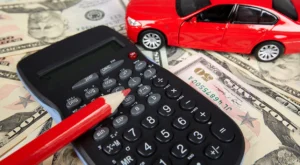Buying a car is a major financial decision, and for most Americans, car financing is the go-to method to make vehicle ownership affordable. Whether you’re buying new or used, understanding how to finance a car in the USA is essential to securing the best deal and avoiding costly mistakes.
In this guide, we’ll walk you through the step-by-step process of car financing, from checking your credit score to closing the deal.

Step 1: Check Your Credit Score
Before you even start shopping for a car or applying for a loan, it’s essential to check your credit score. This is one of the most critical factors lenders consider when determining whether to approve your car loan and what interest rate to offer you.
Why Your Credit Score Is Important:
- Loan Approval
Lenders use your credit score to assess your creditworthiness—in other words, how likely you are to repay your loan. A higher score increases your chances of getting approved quickly and easily. - Interest Rate (APR)
Your score directly affects the Annual Percentage Rate (APR) of your loan.
- A good to excellent credit score (670–850) typically qualifies you for low interest rates, saving you hundreds or even thousands of dollars over the life of the loan.
- A fair score (580–669) may still get you approved, but with higher interest rates.
- A poor score (below 580) can lead to loan rejections or extremely high rates, making your car significantly more expensive in the long run.
- Loan Terms
Lenders may also restrict the length of the loan or loan amount you qualify for based on your credit. Good credit gives you more flexibility in choosing terms that suit your budget.
Credit Score Impact Table:
| Credit Score Range | Loan Impact |
| 670–850 (Good–Excellent) | Low interest rates, best terms |
| 580–669 (Fair) | Higher interest, fewer options |
| Below 580 (Poor) | Loan may be denied or APR very high |
Pro Tip:
Visit AnnualCreditReport.com to check your credit reports free from all three major bureaus: Equifax, Experian, and TransUnion. Review them for errors, such as incorrect account balances or missed payments, and dispute inaccuracies to potentially boost your score before applying.
Taking this simple first step helps you understand where you stand financially and puts you in a stronger position to negotiate favorable loan terms.
Step 2: Set a Realistic Budget – What You Can Truly Afford
Before you begin shopping for a car in the USA, it’s essential to determine how much you can realistically spend. A car is a significant financial commitment, and setting a proper budget helps you avoid unnecessary debt, stress, and long-term financial strain.
What Should Your Budget Include?
When calculating your car budget, consider more than just the sticker price of the vehicle. Here are the core components to include:
Down Payment: This is the initial amount you pay upfront when purchasing the car. A larger down payment reduces the total loan amount and can result in lower monthly payments and interest charges.
Monthly Loan Payment: This is the amount you’ll pay each month toward the car loan. It includes both the principal and interest. The size of your monthly payment depends on the total loan amount, interest rate, and loan term.
Car Insurance: Auto insurance is mandatory in the U.S., and premiums can vary based on your location, driving history, age, and type of vehicle. Always get a few quotes before committing to a car.
Gas, Maintenance, and Repairs: These operational costs are often overlooked. Fuel prices fluctuate, and regular maintenance like oil changes, tire rotations, and unexpected repairs should be factored into your monthly car ownership costs.
General Budgeting Rule: The 15% Guideline
A widely recommended rule is that your car loan payment should not exceed 15% of your monthly take-home pay. For example, if your net income (after taxes) is $3,000 per month, your car payment should be no more than $450.
Why 15%?
This guideline helps ensure you still have room in your budget for other financial goals and living expenses like housing, savings, groceries, and emergencies while comfortably affording your vehicle.
Bonus Tip: Consider the Total Cost of Ownership (TCO)
Don’t base your decision solely on the monthly payment. Look at the total cost of ownership, which includes all ongoing expenses over the life of the car. This comprehensive view will help you choose a vehicle that truly fits your financial situation.
By setting a realistic and well-planned budget before entering the car market, you’ll be more confident in your choices and better positioned to secure affordable financing.
Step 3: Compare Auto Loan Options – Find the Best Financing for Your Needs
How to Finance a Car in the USA: Once you’ve checked your credit score and set your budget, the next step in financing a car in the U.S. is to compare your auto loan options. Choosing the right lender can save you thousands of dollars over the life of your loan. Auto loan rates and terms can vary significantly depending on where you get financing, your credit profile, and the type of vehicle you’re purchasing.

Here’s a breakdown of the three main options available:
1. Bank or Credit Union Auto Loans
Banks and credit unions are traditional lending institutions and often provide competitive interest rates, especially if you already have an account with them.
Advantages:
Lower Interest Rates – Especially for credit union members
Preapproval Available – Know your budget and rate in advance
Great for Buyers with Good-to-Excellent Credit
Why Choose This Option?
If you have a solid credit history, working with a bank or credit union can help you secure better loan terms than what dealerships offer. Preapproval also strengthens your negotiating position.
2. Dealership Financing
Dealerships often offer financing directly through manufacturers or third-party lenders. This method is convenient because you can apply for the loan and buy the car in one place.
Advantages:
- Quick and Easy Process
- Promotional Offers Available – Some manufacturers offer 0% APR or cash-back deals (for well-qualified buyers)
- One-Stop Shop
Downsides:
- Interest rates are often higher, especially if you don’t qualify for special offers.
- Some dealerships may upsell unnecessary add-ons or extended warranties.
When to Use:
If you’re short on time or have excellent credit and qualify for a 0% APR promo, dealership financing can be appealing. Just make sure to compare offers before accepting.
2. Online Lenders
Online lenders have become increasingly popular for auto loans due to their speed, convenience, and transparency.
Advantages:
- Fast Applications & Quick Quotes
- Easy to Compare Rates from multiple lenders
- Examples: LightStream, Carvana, Capital One Auto Navigator
Why It’s a Smart Option:
Online lenders can be great for shoppers who want to compare offers instantly, especially if you prefer a digital-first experience. They may also cater to a wider credit range.
Pro Tip: Get Preapproved Before You Shop
Preapproval gives you a clear idea of how much you can borrow, what interest rate you qualify for, and what your monthly payments might be. This makes you shop like a cash buyer, which boosts your negotiating power at the dealership.
Summary Table
| Financing Option | Best For | Pros | Cons |
| Bank/Credit Union | Strong credit buyers | Low rates, preapproval | May be slower |
| Dealership | Convenience seekers | Fast process, promos | Higher interest, upsells |
| Online Lenders | Rate shoppers | Fast, easy comparisons | Less personal service |
Taking the time to compare multiple financing sources will help you secure the best deal and avoid overpaying. Don’t rush this step—shop smart and negotiate with confidence.
Step 4: Choose the Right Loan Terms

When financing a car in the USA, selecting the right loan term is crucial to managing your monthly budget and overall cost. Auto loan terms generally range between 36 to 72 months (3 to 6 years), and your choice affects both the monthly payment and the total interest you’ll pay over the life of the loan.https://finanacialconsultancy.com/
Loan Term Breakdown:
| Term | Monthly Payment | Total Interest Paid |
| Shorter (36 months) | Higher | Less |
| Longer (72 months) | Lower | More |
Example:
Let’s say you finance a $20,000 car loan at a 6% APR:
- 36-month term: You’ll pay around $608/month, with less interest overall.
- 72-month term: You’ll only pay about $332/month, but you’ll pay much more in interest over time.
Pro Tip:
It may be tempting to choose a longer term for the lower monthly payment, but doing so could put you at risk of being “upside-down” on your loan — meaning you owe more than the car is worth, especially in the early years of the loan.
Best Practice: Stick to a loan term of 60 months (5 years) or less to stay financially secure and reduce total interest payments.
Choosing the right loan term balances affordability with long-term savings. Always run the numbers and consider your financial goals before committing.
Step 5: Make a Down Payment
A solid down payment can significantly improve your car financing terms. It’s generally recommended to put down 10–20% of the vehicle’s price.
Benefits of a larger down payment:
- Lower monthly payments
- Increased chances of loan approval
- Reduced total interest over the loan term
Tip: If you can afford more upfront, it can save you thousands in the long run.
Step 6: Review the Loan Agreement Carefully
Before signing, read the entire auto loan agreement thoroughly. Pay special attention to the following:
- Interest Rate (APR) – Know the cost of borrowing
- Total Repayment Amount – Understand the full cost of the loan
- Prepayment Penalties – Check if there are fees for early payoff
- Hidden Fees or Add-Ons – Watch out for unnecessary extras like:
- Extended warranties
- GAP insurance
- Service packages
Avoid optional extras unless you’ve researched and truly need them.
Step 7: Finalize the Deal and Set Up Payments
Once you’ve reviewed your loan terms and are comfortable with your monthly payment, interest rate, and total loan cost, it’s time to finalize the deal. This is a crucial step in the car financing process and marks the official beginning of your repayment journey.
-
Sign the Paperwork
Carefully read and sign all required loan documents and purchase agreements. These include the loan contract, buyer’s order, title paperwork, and any add-on service agreements. Never sign anything you don’t fully understand—ask questions if anything seems unclear.
-
Set Up Automatic Payments
To stay on top of your car loan and protect your credit score, it’s wise to set up automatic payments through your bank or lender. This ensures that your monthly payments are made on time, every time. Many lenders even offer a small discount on your interest rate if you opt for autopay.
-
Request a Copy of Your Loan Agreement
Always ask for a copy of the signed loan agreement and keep it in a secure place. This document outlines all the terms of your loan, including interest rate, length, monthly payment, and fees. Having it on hand will help you track your loan status, catch errors early, and provide proof if any issues arise.
Finalizing your car financing deal properly ensures peace of mind and helps you maintain control over your financial future.
Car Financing Example
| Item | Amount |
| Car Price | $25,000 |
| Down Payment | $5,000 |
| Loan Amount | $20,000 |
| Interest Rate (APR) | 5% |
| Loan Term | 60 months |
| Monthly Payment | ~$377 |
| Total Interest Paid | ~$2,620 |
Common Car Financing Mistakes to Avoid

When financing a car, it’s easy to make costly mistakes that can affect your financial health for years. Here’s a breakdown of common errors to avoid:
- Not Getting Preapproved
Failing to get preapproved for a loan before visiting a dealership can leave you vulnerable to higher interest rates. Preapproval from a bank or credit union gives you a benchmark rate and strengthens your negotiating position. - Focusing Only on the Monthly Payment Instead of the Total Cost
Many buyers get lured by lower monthly payments without realizing the trade-off—longer loan terms and higher overall interest. Always calculate the total loan cost (price + interest + fees) rather than just focusing on what fits into your monthly budget. - Skipping Comparison Shopping for APRs
Accepting the first financing offer without comparing other lenders can cost you thousands over the loan term. Different lenders offer different Annual Percentage Rates (APRs) based on your credit score, so it pays to shop around. - Financing for More Than 60 Months
Extending your loan beyond five years (60 months) might reduce monthly payments, but it usually leads to more interest paid over time. Additionally, the longer the term, the higher the risk of being “upside down”—owing more than the car is worth. - Rolling Negative Equity from a Previous Car Loan
If you still owe money on your current car and trade it in, dealers may roll the remaining debt into your new loan. This increases the new loan amount and puts you at a financial disadvantage from day one.
Final Thoughts
Car financing in the USA doesn’t have to be a daunting or complicated process. By taking the time to research your credit score, understand the different types of auto loans available, and shop around for the best financing options, you place yourself in a stronger position to make informed decisions. Carefully comparing lenders, loan terms, and interest rates ensures you don’t overpay over the life of the loan. Pre-approval gives you negotiating power, while reviewing loan terms protects you from hidden costs. Once you’re confident in your decision, finalizing the deal and setting up automatic payments will help you manage your loan responsibly and avoid missed deadlines that could damage your credit. Ultimately, by following a step-by-step approach, you can finance your car in a way that fits your budget, supports your financial goals, and gives you peace of mind behind the wheel. Whether it’s your first car or an upgrade, smart car financing puts you on the road to financial freedom.
Ready to finance your next car?
Get personalized advice or loan comparison help from financialconsultancy.com.
Frequently Asked Questions (FAQ)
Q: Can I finance a car with bad credit?
A: Yes, but expect higher interest rates. Consider making a larger down payment or using a cosigner.
Q: What is the best loan term?
A: 36–60 months is ideal. Shorter terms save on interest, but longer terms offer lower monthly payments.
Q: Should I finance through a dealership?
A: Dealership financing is convenient, but may be more expensive than a bank or credit union loan.
